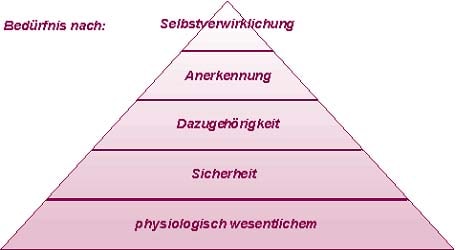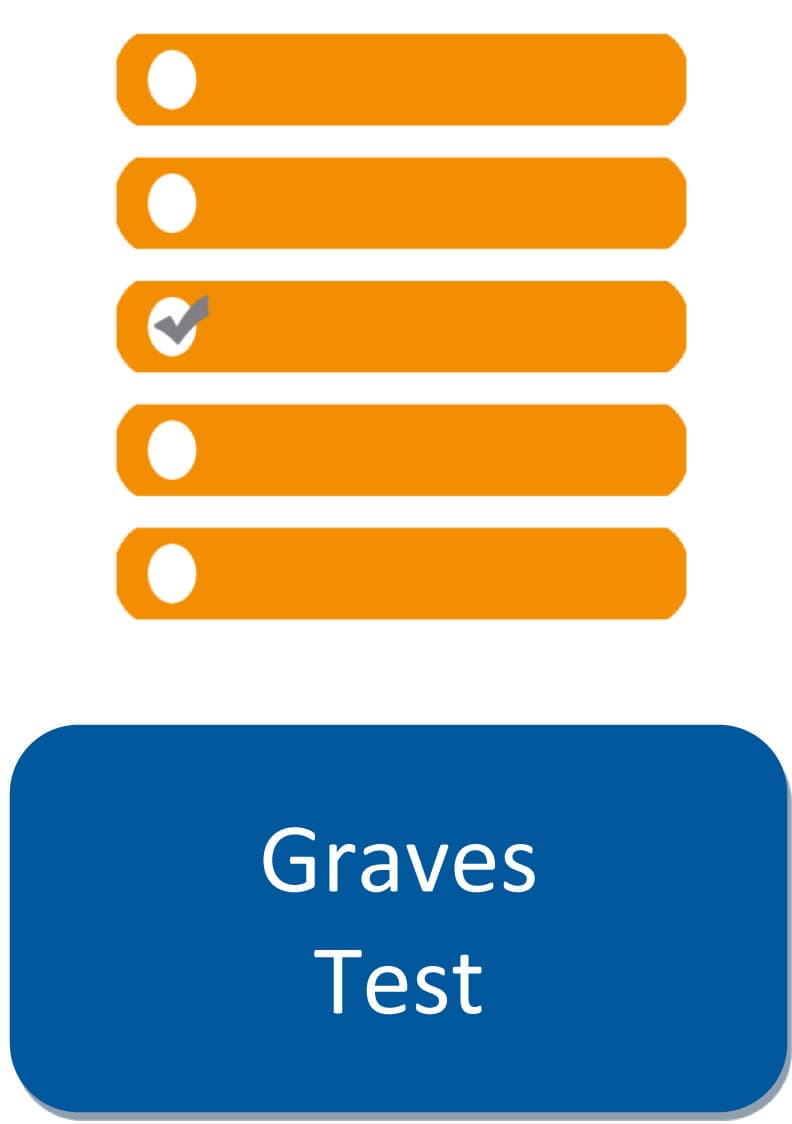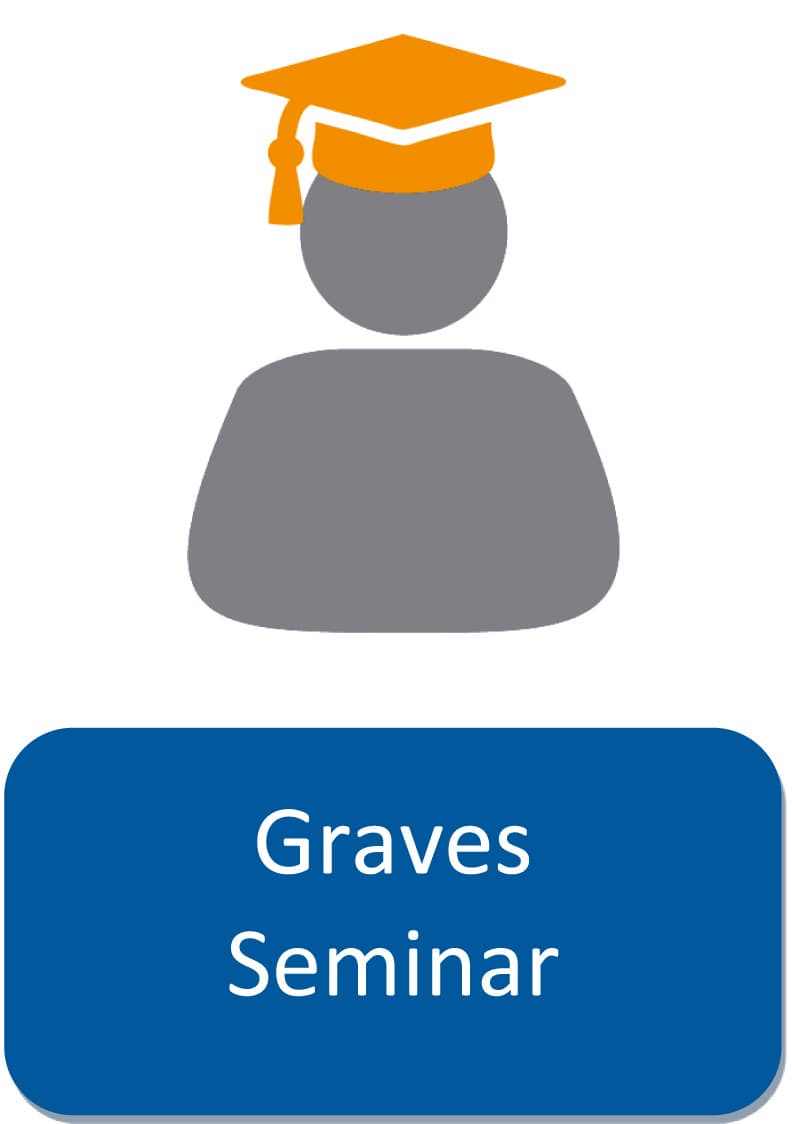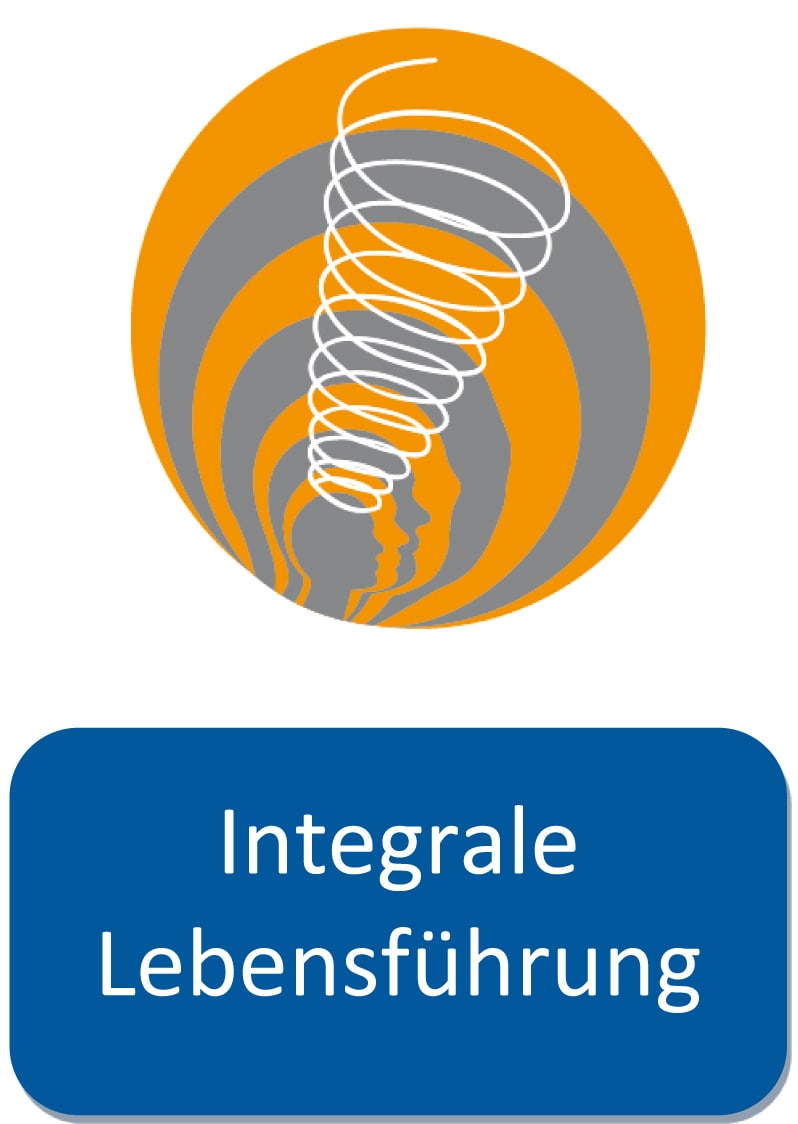Graves Model (often also called Spiral Dynamics)
The Graves Model is often referred to as Spiral Dynamics. The new term was introduced by Don Beck, a student of Clare Graves. The term has become common in many areas, especially since Ken Wilber also uses it frequently.
The Graves Model particularly fascinates the Landsiedel team. Therefore, we have developed our own test for this model. You can take it online for free and also receive an evaluation. In which area of the Graves Model are you currently located? Find out!
We also offer a special five-day seminar on the Graves Model with Rolf Lutterbeck, one of the leading Spiral Dynamics experts in the German-speaking world.
Further information about the Graves Model can be found in the e-book written by Stephan Landsiedel on this topic. You can download the e-book free of charge.
The Graves Model and the approaches of Ken Wilber are also an essential part of our annual program “Integral Life Leadership.”
Maslow’s Hierarchy of Needs
Abraham Maslow’s hierarchy of needs was the most famous model for human ontogenetic development in the 1930s. However, his theory was not well-founded and gave Clare Graves – a contemporary of Maslow – reason for criticism.

He considered Maslow’s view of the self-actualizing human being too inflexible. He did not accept Maslow’s endpoint as the end of development, since Graves believed that certain value systems (= memes) had developed as reactions to certain human existential conditions. Such memes are both psychological attempts to respond appropriately to historical existential conditions and counter-movements to the prevailing value system (antithesis).
Graves Levels
1. About Clare W. Graves
Clare W. Graves (1914–1986) was an American psychology professor at Union College in New York and, with his meme model, the pioneer of Spiral Dynamics. The impulse for developing this model came from central questions posed by his students: Why are people different? Why do some change? Why do people understand the highest goal of human development — “self-actualization” — in such completely different ways?
Graves’ answer was: “Briefly summarized, I claim that the psychology of mature human beings is an unfolding, emerging, oscillating, spiral process marked by the subordination of older, lower-order behavior systems to newer, higher-order systems as existential problems of human existence change.”
By this he meant that human development is continuous and never complete. It changes as the existential conditions of humanity change, producing new systems in which the old ones are integrated. When a new system or stage emerges, we also change our psychology and our habits to adapt to these new conditions. The most diverse forms of life are possible within this potentially open value system. There is no final stage that everyone must reach. Individuals, companies, or even entire societies can only respond positively to management principles, motivational incentives, educational guidelines, and moral or ethical ideas that correspond to their current stage of human existence.
Learn more about Spiral Dynamics in the online seminar recording with Stephan Landsiedel:
Graves Value Model:
The emergent, cyclical double-helix model of mature adult biopsychosocial behavior
Short Description
Each class of problems or challenges is solved by creating a value system. So far, humanity has developed eight different value systems. Such value systems are mechanisms developed by the psyche to deal appropriately with specific environmental situations. When the problems and challenges that a person or society faces change, their value system also changes. Therefore, value systems are appropriate when they enable congruent problem-solving behavior, but they should not be compared independently of their context.
Emergent = arising
Value systems emerge anew through changes in the environment.
Cyclical Double Helix
Each value system arises at the intersection of two forces — the problem and the respective problem-solving approach.
A value system reflects how people think — that is, their values and belief structures. However, they must not be confused with the topic or content of thinking itself. Value systems are rather a framework or way of thinking. Often, value systems that seem diametrically opposed — for example, a fundamentalist religion and so-called “atheistic communism” — are simply expressions of one and the same value system.
The Graves Model has enormous explanatory and predictive power and is applicable to all aspects of biological, psychological, and sociological behavior. It explains both individual behavior and international political interactions: differences in thinking regarding religion, the meaning of human existence, economics, politics, family, education, health, and leisure, as well as different patterns in goals, ethics, motivation, lifestyle, and organization. The emergence or disappearance of each system is triggered by forces in the environment in which that system exists. However, the deep structures of the Graves Model correspond to ways of thinking — not types of people. These patterns represent biopsychosocial systems and are neither typologies of people nor discrete developmental stages. They reflect systems within the repertoire of human behavioral possibilities, meaning that every person possesses certain mental patterns that can be activated by different contexts and situations.
The Characteristics of the Levels
The emergent-cyclical double-helix model for the biopsychosocial development of adults postulates eight levels:
- Beige: Reactive, instinctive, archaic — survival and the struggle for existence are central.
- Purple: Animistic, tribal, safety-oriented — the person sacrifices their own wishes for the tribe, the chief, or the spirits.
- Red: Egocentric, self-oriented, hedonistic, impulsive — the self wants to express itself here and now, regardless of others.
- Blue: Absolutist, conformist, religious — the self sacrifices for later reward (in heaven, etc.).
- Orange: Success-oriented, materialistic, rational — the self calculates its own interests to avoid conflict with others.
- Green: Personalistic, group-oriented, humanistic — the self is ready to sacrifice for others.
- Yellow: Systemic, existential, functional — the self seeks self-expression but not at the expense of others.
- Turquoise: Experiential, globally thinking, synergistic — the self is ready to sacrifice so that life can continue.
The Problems of the Levels
Each level of the Graves Model represents a strategy and an answer to a class of problems. Therefore, each level can be seen as a link between a group of problems or challenges and the corresponding ways humans develop to deal with them.
| Symbolism | Meaning |
|---|---|
| Beige | Maintaining physiological stability and integrity |
| Purple | Achieving relative security |
| Red | Living with self-awareness |
| Blue | Achieving lasting peace of mind |
| Orange | Conquering the physical universe |
| Green | Emphasizing interpersonal values |
| Yellow | Restoring quality of life in a “sick” world |
| Turquoise | Accepting existential dichotomies |
The Levels
The following table summarizes the different levels, their worldviews, and their successful reactions:
| Level | State of the World | Effective Reactions |
|---|---|---|
| 1st Level: State of Nature (Beige) |
State of nature with food scarcity, no protection or security | Behavior is survival-oriented, like animals |
Level 1: Reactive, Automatic Meme
Small groups and bands focused primarily on biological survival. At this developmental level, all energy is directed toward survival. People on this stage live only in the present. In pre-tribal cultures, this “animal-like” way of life existed; today, it can be found in children, mentally disabled or senile individuals, and sometimes in drug addicts. This state can also be triggered by extreme stress or life-threatening situations.
“Survival at Any Cost”
Beginning:
about 100,000 years ago
Maxim:
Self-expression aimed at survival
Perspective:
The world is uncertain and vague, driven by biological imperatives. Life is instinctive and consists of submitting to the will of nature without resistance.
Life Goal:
Immediate satisfaction of recurring physiological needs (food, drink, security) to ensure the survival of the species.
Strategies:
Reacts automatically to environmental changes for the sake of survival. Moves and adapts quickly depending on available resources and necessities. Dependent on life-supporting systems with minimal awareness of self and others. Small social groups cooperate to gather food or hunt, avoid dangers, and reproduce. Behavior is based mainly on the stimulus-response model, with instinct as the key to survival.
Forms of Expression
- Low: Helpless, oscillating between life and death, minimal perception of reality
- High: Self-sustaining at a basic level, passively interacting with reality, focused on survival values
Organizational Structure:
Small groups, herd-like behavior. The strong protect the weak; groups gather for mating, food collection, and migration. Movement patterns follow weather and food resources.
Learning System:
Genetic programming, habits
Learning Style:
Activation of instinctive memory, observational learning; primary input through touch and taste; no conceptual learning.
Learning Motivation:
Driven by immediate physiological needs
Share of Adult Population:
approx. 0.1%
Level 2: Tribalistic, Animistic Meme
The energy of self-sacrifice is now directed toward the survival of the tribe; attention is focused on the present and the past. People are dependent on the chief or the clan. This mindset dominated most pre-literate cultures and can still be found today in diluted form in clubs, close family units, sports teams, as well as in parts of Africa, South America, Oceania, and the Arctic.
“There is no such thing as chance.”
Beginning:
about 50,000 years ago
Maxim:
Sacrifice one’s own desires for the sake of the tribe, the chief, or the spirits.
Perspective:
The world is mysterious, full of good and evil spirits that control existence. The clan and sacred objects must be protected from dangers.
Life Goal:
To maintain safety and protection by adhering to tribal traditions, ready to sacrifice oneself for the tribe.
Strategies:
Reliance on magic, totems, taboos, or omens to appease spirits. The individual finds safety and identity only within the family, clan, or tribe, accepts their assigned role, and takes pride in the tribe and its symbols.
Forms of Expression
- Low: Extremely dependent on the chief and/or a cult; anxiously concerned with observing taboos and rituals.
- High: Loyal and trustworthy; finds strength and safety under a caring chief or in a supportive family; inspired by heroic examples.
Organizational Structure:
A tribe led by a council of elders (shamans, chiefs). Roles are determined by gender, age, and physical strength. The norms of the tribe are sacred and rigidly defended, demanding absolute obedience.
Learning System:
Classical conditioning through association of different experiences.
Learning Style:
Reflexive — a paternalistic teacher conditions desired responses to certain sensory inputs; learning is need-based and imitative (copying others’ behaviors); procedural (step-by-step), ritualistic, and repetitive. Rituals structure daily life, aiding both memory and automated behaviors. Magic, imagination, symbols, and drawings are often used since most people are illiterate. Repetitive music supports long-term memory through chants and scents as anchors.
Communication:
Information is transmitted only through the clan leader; written words are considered unreliable.
Learning Motivation:
Tangible recognition for achievements; interest in anything that increases safety or fulfills biological needs.
Share of Adult Population:
approx. 10%
Level 3: Egocentric, Exploitative Meme
This is the stage of the dominant, macho-type worker — a phase where energy is invested in self-expression to achieve immediate gratification of sensory desires, regardless of others. This attitude is found today mainly in repressive political regimes and dictatorships. It also emerges in outbreaks of urban violence, wars, and among drug gangs.
“I take whatever I can get — as long as I don’t get caught.”
“The law of the strongest.”
“I want everything — and I want it now.”
Beginning:
about 10,000 years ago
Maxim:
Impulsive self-expression without regard for others.
Perspective:
The world is full of aggression, hostility, and selfishness — ruled by power.
Life Goal:
To gain and exercise power in order to satisfy one’s own needs. Power is seen as the only way to achieve satisfaction and resist imagined or real oppression. Independence is valued above the thoughts and feelings of others. Respect is sought; shame and humiliation are avoided.
Strategies:
Willing to use any means necessary to exploit others and maintain control. Such individuals have no guilt, trust only themselves, and are obsessed with preserving their reputation and dominance.
Manifestations:
This lifestyle prevailed in hedonistic empires; today, it can be found in dictatorships, certain child developmental stages, warlord cultures, gang violence, and even in some aggressive rap lyrics.
- Introverted: Cynical, bitter, passive-aggressive, and hostile.
- Extraverted: Showy (clothing, cars), rebellious, risk-taking, attention-seeking.
Forms of Expression
- Low: Self-destructive, rebellious, unable to conform to social norms, extremely exploitative, often lawless and cruel.
- High: Spontaneous, energetic, demanding, willing to break traditions, innovative, and autonomous.
Organizational Structure:
Empire; strong top-down hierarchy; strength defines relationships. Work is done only under supervision; everyone looks out for their own benefit.
Communication:
Logical arguments and general politeness are irrelevant. What matters is convincing others of personal advantage.
Learning System:
Operant conditioning — learning through reward for success.
Learning Style:
Punishment is counterproductive; mutual respect is essential. Learning occurs through trial and error.
Learning Motivation:
Success must bring immediate gratification, otherwise it’s irrelevant.
Share of Adult Population:
approx. 15%
Level 4: Absolutist, Sacred Meme
In the Graves Model, this level is primarily conformist:
The typical middle class, for example in the United States, lives mostly within this value system. Present needs are sacrificed for future rewards — this is the first stage where the idea of delayed gratification emerges. The highest principles are obedience, order, and maintaining the system — a necessary step toward developing an organized and progressive society among emerging nations. In its pure form, this type can be found in doctrinal religions, absolutist philosophical or political systems, and most clearly in military and religious hierarchies.
“I sacrifice myself for the cause / organization.”
“Give up now, reap later.”
Beginning:
about 5,000 years ago
Maxim:
Do what the higher order demands of you — without question.
Perspective:
The world is deterministic and rationally ordered. People and things are classified into rigid categories.
Life Goal / Motivation:
To conform to the moral framework — to distinguish right from wrong, maintain control, avoid guilt and punishment.
Strategies:
Obey rules, live an orderly existence, support the system through sacrifice and discipline.
Organizational Structure:
Passive hierarchy; strict rules governing order and rank.
Learning System / Style:
Avoidance-based learning (“away from”), indoctrination through authority figures.
Example:
You believe in God (a devout Christian) and strictly follow the rules of the Church. You know the Bible well and consider it the one and only truth. There is only one correct way. You obey the rules, live in stability and order.
Share of Adult Population:
approx. 30%
Level 5: Multiplistic, Materialistic Meme
The self wants to set and achieve its own goals — it seeks material rewards but in a way that avoids provoking envy or hostility from others. At this stage, we find the capitalist and materialist mindset. This level is about calculated self-expression — pursuing success without overtly disturbing others, but with the clear intention of immediate reward and profit. The materialist believes success comes through skillful manipulation of systems. This is the cornerstone of thinking in modern industrialized nations and is reflected in highly technological societies, sales, marketing, and advertising.
“I want to maximize my profit.”
Beginning:
about 300 years ago
Maxim:
Behave strategically to avoid stirring up resentment or envy in others.
Perspective:
The world is full of opportunities and resources that promise progress and prosperity for individuals and entire societies.
Life Goal:
- Individual: Achieving goals, popularity, prestige.
- Cultural: Conquering nature, uncovering its secrets, skillfully using resources to create a better life for all. Fatalism is replaced by science and technology; destiny and divine providence are replaced by human control and innovation.
Strategies:
- Individual: Success results from competitiveness, time and energy investment, risk-taking, and a belief in the free market.
- Cultural: Progress is achieved through pragmatic innovation; realpolitik that is both ideological and success-driven; free enterprise, competition, and technological advancement are encouraged.
Manifestations:
A materialistic worldview dominant in Western industrial nations — dependent on constant technological innovation. Most people are status-conscious and strive to climb the social hierarchy.
Forms of Expression
- Low: Deceptive, extremely self-serving, ruthless; people without moral backbone.
- High: High energy level, pragmatic, achievement-oriented.
Organizational Structure:
Hierarchical, bureaucratic — status-oriented; functional authority is a key quality for decision-makers.
Communication:
Flows top-down and laterally; people are interested only in what benefits them — career, money, reputation.
Learning System:
Expectation-based learning: goals must satisfy personal needs. Learners require rewards to stay motivated and learn best through personal effort and changing environments.
Learning Style:
Trial and error; experimental learning; motivated by technology and competition. They enjoy analyzing and improving things; driven by a compulsion to be the best — often leading to chronic stress and heart disease. Mastering the rules of a system is not an end in itself but a means to win. Losing is experienced as failure and exhaustion.
Learning Motivation:
Grades, career advancement, improved social status.
Example:
You are a successful young entrepreneur. You are in the market to win — and you are very successful. You work hard and make good money. You are optimistic, take risks, and use Earth’s resources to live in abundance. You have attended many training programs and know the “laws of success.” You seek autonomy and independence, love competition — like J.R. Ewing from *Dallas*.
Share of Adult Population:
approx. 30%
Level 6: Personalistic, Relativistic Meme
Personal needs are set aside for the sake of others so that everyone can live well together. At this personalistic, humanistic stage, energy is directed toward self-sacrifice with the goal of creating well-being for all. This level emerges as a reaction to prosperity and to a highly technological, alienated, and impersonal society. The main concerns are equality, social welfare, and humanitarian progress.
“Team Human.”
“Together we are stronger.”
“Together we can do it.”
Beginning:
about 150 years ago
Maxim:
Willingness to sacrifice oneself to improve life for oneself and others.
Perspective:
Rediscovery of fundamental human values. The world feels depersonalized and materialistic; humans are dominated by technology, leading to spiritual emptiness that can only be filled through compassion and humanity.
Life Goal:
To achieve inner peace and believe that people need one another. To end human exploitation, consumerism, and rigid control. To overcome hunger, racism, gender inequality, and social alienation.
Strategies
- Individual: “I + You” relationships are central. Strives for a society based on equality and humanity. Emotional and spiritual needs take priority over material ones.
- Cultural: The goal is an egalitarian society where everyone can realize their full human potential. All needs must be treated equally (moral imperative). Persuasion, legal means, cooperation, harmony, and peacekeeping are the methods of choice.
Manifestations:
In the late 1960s and early 1970s (anti-Vietnam movement, hippie movement), civil rights activism and the human potential movement arose. This mindset is common among helping professions (social workers, teachers), especially in Scandinavia, and is gaining influence in Germany, Japan, and Switzerland. It’s a reaction to alienation and industrialization — aiming at social justice, equality, and humanitarian progress.
Forms of Expression
- Low: Overly permissive, unrealistic, idealistic; emotions are overemphasized while tangible results and productivity lose importance.
- High: Genuine empathy and orientation toward others’ interests; individuals radiate calm and balance; value warm, responsible relationships and social accountability.
Organizational Structure:
Social networks where all members participate equally for mutual benefit. Status and privilege lose importance; focus is on the human factor and collective progress.
Communication:
Frequent communication in all directions. Consensus-seeking and “what’s in it for each participant” are central themes.
Learning System:
Learning through shared experience and empathy.
Learning Style:
Exploring and acknowledging feelings are key first steps. Teaching should include modeling, feedback sessions, and experiential understanding. Authority figures are rejected unless they integrate themselves. Cooperation and acceptance are essential for productive learning; competition hinders motivation. The main risk is excessive tolerance.
Learning Motivation:
Mutual encouragement and group support.
Example:
You seek inner peace. Your emotions and relationships mean more to you than cold rationality. You care deeply about others and build meaningful connections. You listen well and bring harmony to people’s lives (e.g., Carl Rogers).
Share of Adult Population:
approx. 15%
Level 7: Systemic, Existential Meme
The self expresses itself freely — but not at the expense of others or the environment. Improvement without ambition is a hallmark of this level. It responds to competence, reason, and necessity, not to status, seniority, or group loyalty. Free from internal constraints, it focuses on flexibility, individual capability, self-motivation, and tolerance for paradox. People work in systemic, adaptive, and fluid organizations capable of dealing with complexity, uncertainty, and rapid change.
“Flexibility, spontaneity, and functionality are top priorities.”
“There are always many possibilities.”
Beginning:
about 50 years ago
Self-Expression:
Free expression, but not at others’ expense.
Perspective:
The world is on the brink of collapse due to exploitation of people and nature. Life is viewed as diverse, paradoxical, and multi-layered. The goal is to restore balance between humanity and nature.
Life Goal:
To reconnect humans with nature and address global problems. Despite rapid change, live as functionally and consciously as possible.
Strategies:
Reevaluate humanity’s relationship with the world to ensure survival. Theoretical background: autopoietic systems, self-regulation, and complexity theory.
Characteristics:
People at this stage strive to improve their performance without competitiveness. They compare themselves only to their own past and future potential (ideal self). Competence, reason, and necessity matter — authority, age, dogma, or group identity do not. They take pride in their work but dislike excessive praise. They stand for their rights without paranoia or hostility. These people are internally free and able to enjoy life, emphasizing flexibility, self-direction, and tolerance for ambiguity. Traditional hierarchies and imposed responsibilities are rejected.
Organizational Structure:
Systemic flow — for every task there is an appropriate structure. Organizations are adaptive and responsive to uncertainty and rapid change.
Manifestations:
Emerging gradually in Western cultures as an intellectual attitude (e.g., second-order cybernetics, systems thinking).
Learning Style:
Informational and self-directed access to knowledge and materials.
Forms of Expression
- Low: Primary focus is self-preservation; avoids dealing with secondary problems.
- High: Acceptance of diverse experiences; functionality and quality of “being” are top priorities.
Learning Style:
Informational learning using all representational systems. Learners control their pace and environment. Goals are often open-ended, and development unfolds naturally, without fear or pressure. Competition and the need for approval are absent. They use available resources and work best in unstructured environments with freedom over their time.
Learning Motivation:
Self-set learning goals and self-generated rewards — not external ones.
Example:
You see that the world is in danger of ecological or military collapse due to misuse of resources. You want to reconnect people with nature and continually improve your own capabilities. Knowledge and competence matter more to you than rank or power. The greatness of existence is more important than material wealth. You are flexible, open to many experiences, and guided by intrinsic motivation. You might write books to help humanity avoid collapse. You recognize systemic interconnections and point them out to others.
Share of Adult Population:
approx. 1%
Level 8: Transpersonal, Global Meme
The self is willing to sacrifice itself and others if necessary for the survival of life on the planet. This level of the Graves Model represents humanity’s response to the growing problems of global coordination and survival. The preservation of life on Earth becomes the central goal — to which both the self and others must subordinate themselves.
“Everything is connected and must be viewed as a whole.”
Beginning:
about 30 years ago
Maxim:
Willingness to sacrifice oneself or others if required for global survival.
Perspective:
A world heading toward geopolitical collapse, where short-sighted solutions threaten the entire ecosystem.
Life Goal:
To establish meta-solutions beyond geopolitical and economic boundaries. To avoid war, eradicate hunger and disease, and overcome political oppression.
Strategies:
Transcend traditional human boundaries and build global networks. New ways of living emerge that allow every individual to thrive without harming the collective. Human needs must be reconciled with the planet’s limited resources — even if self-sacrifice is required to maintain the integrity of life as a whole.
Manifestations:
The ideas of post–New Age spirituality form the foundation of this level.
Forms of Expression
- Low: “The space cadet.” (detached, abstract idealism)
- High: Prophet — visionary leader working for planetary consciousness.
Organizational Structure:
A holistic organism in which each part contains the whole. Meta-management integrates competence and consensus so that individual and collective interests align with the well-being of the planet. Complex models combine physics and metaphysics in a unified global information process (e.g., theories of the holistic universe or morphic fields). Information from around the world is synthesized to understand and influence Earth as a living system.
Communication:
Information is shared freely as long as it is not imposed or authoritarian.
Learning Style:
Experiential learning that enhances awareness and expands consciousness. Rather than introducing new “learning tools,” this stage improves the learning process itself — reducing fear, accelerating understanding, and emphasizing interconnectedness. Learners engage with people in different states of consciousness. Education becomes an interactive, global process — a collective exploration among thinkers around the world. Thinking is intuitive, transrational, and holistic, integrating sensory, emotional, and meta-cognitive processing.
Learning Motivation:
Life itself is learning.
Example:
You are one of the leading minds on this planet in the field of consciousness development. You experience the unity of all existence. The world is a single, dynamic organism with its own collective spirit. Everything is connected; energy and information drive all events on Earth. You think holistically and intuitively and are ready to sacrifice yourself for global survival. You are a visionary developing meta-solutions that transcend geopolitical and economic limits — aiming to preserve life, prevent war, and end hunger, disease, and oppression (examples: Dalai Lama, Ken Wilber, Rupert Sheldrake).
Share of Adult Population:
approx. 0.1%
The Memes in the Spiral Dynamics Model
Introduction
Clare Graves’ students expanded his model and created what is now known as Spiral Dynamics — one of the most precise models of cultural evolution. But Spiral Dynamics is not a one-dimensional system; it does not view people with cold analytical distance. Instead, it offers a clear and deep insight into the flowing patterns of the human psyche. Beliefs and values often unconsciously guide our decisions and shape our identities.
Personal experience is placed within the broader historical context of humanity’s development, which leads to a liberating objectivity. This evolution is part of every human being — stretching from the most primitive survival instincts (Beige) to spiritual aspirations (Turquoise). Spiral Dynamics is represented as a spiral because it reflects natural and cosmic forces visible everywhere — in DNA, galaxies, and beyond.
The spiral’s upward-expanding form best describes the evolution of human consciousness, reflecting an unfolding mindset and increasing complexity. This development began around 100,000 years ago as the “First Tier” (Memes 1–6), driven by basic survival needs. The “Second Tier” (Memes 7–8) represents the “Being Level,” characterized by integrative and transpersonal awareness.

Don Beck and His Theory
The “spiral wizard” Don Beck uses his model to drive systemic transformation within and across various sectors and cultures of the global community. For such large-scale interventions and transformations, he created a new initiative called “Spiral Dynamics Integral” (SDi), designed to enable human transformation and worldwide reconciliation. However, there is still a long way to go, since according to Spiral Dynamics, human nature is not fixed:
Humans can create new worlds — they can adapt to changing situations by developing more complex ways of thinking to solve problems. This requires adaptive, context-sensitive intelligence that can respond to diverse life conditions. For Beck and his colleagues, the driving forces created by life conditions — along with coping mechanisms and collective intelligences — are always at the center of attention.
In Spiral Dynamics, these collective intelligences are called memes. Memes (value systems) behave like genes, viruses, or bacteria — following the same universal principle of regeneration. Each successive meme embodies a more complex organizational principle with its own priorities, mindsets, and guiding lines. This provides a method for solving problems by focusing on what is most important in response to current life conditions.
Like the replicating DNA code, a meme code is a biopsychosocial and spiritual blueprint that spreads throughout culture, shaping survival codes, origin myths, artistic forms, lifestyles, and community values. Crises and conflicts trigger the shift to the next higher stage of human development — yet the spiral will never reach an end state. It continuously expands upward in dynamic evolution. As Ken Wilber notes, each new social stage transcends and includes all previous ones, resulting in greater freedom and complexity.
However, it will take time before humanity fully reaches the Yellow and Turquoise codes. Memes are not types of people but adaptive intelligences within people. Fragments of higher levels already exist, which is why the exchange and cooperation of a “syndicate of creative minds” is so important.
Don Beck: Graphical Representation
| 1st Level Survival, food gathering, reproduction, instinct, basic subsistence mentality | |
| 2nd Level Tribal formation, magic, family rituals | Examples Ancestors, tribal members, shamans |
| 3rd Level Power, egocentrism, myth, emotion, revenge | Examples Heroes, warlords, mafia, cowboys, “Lucky Luke” |
| 4th Level Herd mentality, divine order, law, rules | Examples Scouts, fundamentalists, bureaucracy, socio-/ethnocentric systems |
| 5th Level Rationality, scientific gain, achievement, world-centric, market economy, introspection | Examples Materialists, capitalists, achievers |
| 6th Level Human connection, ecology, equality, relativistic and multicultural mediation | Examples Humanistic psychologists, constructivists, 1968 movement, anti-authoritarian groups |
| 7th Level Integral, a-perspectival, holarchical; growth of the entire spiral; integration of systems; win-win relationships | Examples Chaos theorists |
| 8th Level Holonic; self-sacrifice for the world | Examples Prophets, ecologists, Greenpeace activists |
| 9th Level Astral-psychic, transpersonal 10 Subtle 11 Causal 12 Non-dual | Examples Nature mystics |
The Development of NLP According to Graves
Within just 30 years, NLP has evolved from Graves Level 4 to Level 7.
The first generation of NLP (around 1972) was focused on the creation of simple sequences and techniques.
The Blue value system — “creating order” (Level 4 in the Graves Model) — best describes this initial phase.
Since 1980, the Orange meme developed, with its focus on success and results, leading to massive seminars with firewalking, strong media presence, and persuasion-based methods.
Parallel to the fifth (Orange) meme, the sixth Graves Level (Green) emerged — in the form of sensitivity groups emphasizing team spirit, group dynamics, and playfulness.
In the early 1990s, the fourth generation arose on the Yellow (7th) value system — “Integral and Being Motivation.”
Professional NLP trainings developed a new level of seriousness, ethics, and transformation-oriented content.
This includes visionary leadership, “Tools of the Spirit,” and Core Transformation.
The goal of this stage is to integrate previous levels, expand personal flexibility and freedom of choice, unfold potential at the level of being, and explore meaning and wisdom.
Thus, humanity’s developmental stages are mirrored in the evolution of NLP providers:
5th Level:
Progress brings material prosperity.
“Success is everything!”
Self-employed entrepreneurs focus on profitable business, control, ownership, and mastery.
Huge seminars with firewalking and heavy media coverage are typical.
6th Level:
Material growth enables the question of meaning to emerge.
“Sensitive Community.”
Communities that emphasize belonging, personal growth, harmony, equality, and teamwork.
Seminars focus on experiential learning and emotional connection.
Paradigm Shift: From Deficiency Motivation to Being Motivation
7th Level:
Wealth enables completely new thoughts, hopes, and breakthrough experiences — the age of the Internet.
“Integral, Wisdom, Ethics, and Being Motivation.”
Problems are solved from new perspectives efficiently and effectively — while experiencing a “flow” state.
This includes integration of professional NLP training with transformative topics.
8th Level:
The Earth faces collapse. Humanity risks destroying the planet.
Only a higher-order consciousness and a transpersonal search for global solutions can prevent catastrophe —
the transpersonal level of development.
Application of the Graves Value Model
1. Conflict Resolution (quoted from O.p.a.l.)
In large organizations, there is usually a mix of Blue, Orange, and Green stages — which makes conflict inevitable.
Example:
The “Oranges” reject the “Blues” because they see them as blocking change. They also reject the “Greens,” because they think Greens discuss endlessly and want to include every opinion.
The “Greens” dislike the heartless, money-driven “Oranges,” and they mistrust the hierarchical “Blues.”
Let’s bring this example to life:
Human Resources departments are often “Green” — they focus on employee well-being (e.g., through training and development programs).
Management, on the other hand, is often “Orange.”
For them, employee performance is the top priority.
As a result, some leaders consider HR programs a waste of time.
The “Greens” judge the “Oranges,” and the “Oranges” do not understand the “Greens.”
Do you see similar conflicts in your organization?
What are your hypotheses?
The problem is that every person and organization considers their own stage as the only right one — and judges the others.
At our current level, we also devalue the stages we have already surpassed.
We feel superior to those on lower stages, and we cannot yet understand those above us.
Only from the Yellow stage (7 in the Graves Model) do we gain an integral perspective — appreciating people at all levels equally.
2. Application in Leadership
2.1 Challenges in Organizations
An individual, a company, or even an entire nation can only respond positively to management principles, motivational incentives, educational methods, and moral values that correspond to their current level of development.
This means that each stage requires different leadership, communication, and management styles.
“Blue” employees, for example, can be motivated with titles or symbols of authority.
“Orange” employees respond better to performance-based bonuses.
But these same incentives would not work with “Green” employees — for them, teamwork in a meaningful project is far more motivating.
However, our stage of development is not static — it evolves.
Each person and system gradually grows upward as environmental complexity increases.
When we reach a new level, our worldview, thinking, and lifestyle change to adapt to new conditions.
The earlier stages remain within us, integrated.
Still, people or systems can regress under pressure or crisis.
For instance, during a recession or mass unemployment, social (Green) thinking may collapse into a harsh competition mindset (Orange or Red).
Once the crisis is overcome, we usually return to our previous level of development.
What consequences does this knowledge about the stages of development have for your daily work life?
Exercises for the Graves Model
Think back to a situation with an employee, a colleague, or a supervisor that felt tense or conflict-laden.
Choose someone you believe operates on a different stage of development.
Keep the following points in mind:
- Each person evaluates things differently because they think differently — and people think differently because their brains are wired differently!
- Different organizations occupy different positions on the “psychological map,” and therefore must develop distinct management strategies that fit their people and contexts. Managers should maintain a consistent, systemic approach so that all parts work together cohesively.
- This approach ensures effective recruitment, selection, placement, and training — aligning employee development, management, and marketing into one coherent system. Organizations should structure their management systems from the bottom up to meet employees appropriately — and since people keep evolving, the system must evolve too.
- Marketing strategies often fail because they reflect the designer’s value system rather than that of the target audience.
- Therefore, the question is not “How can I motivate people?” but “How can I align my actions with their natural flow of motivation?”
- The current productivity challenges we see in modern culture are not signs of decay — but signs of growth. We must therefore find new ways of working with people that match what we have become. Learners, trainers, and teaching strategies must all be aligned.

 Deutsch
Deutsch English
English Français
Français 中文
中文 Español
Español नहीं
नहीं Русский
Русский



